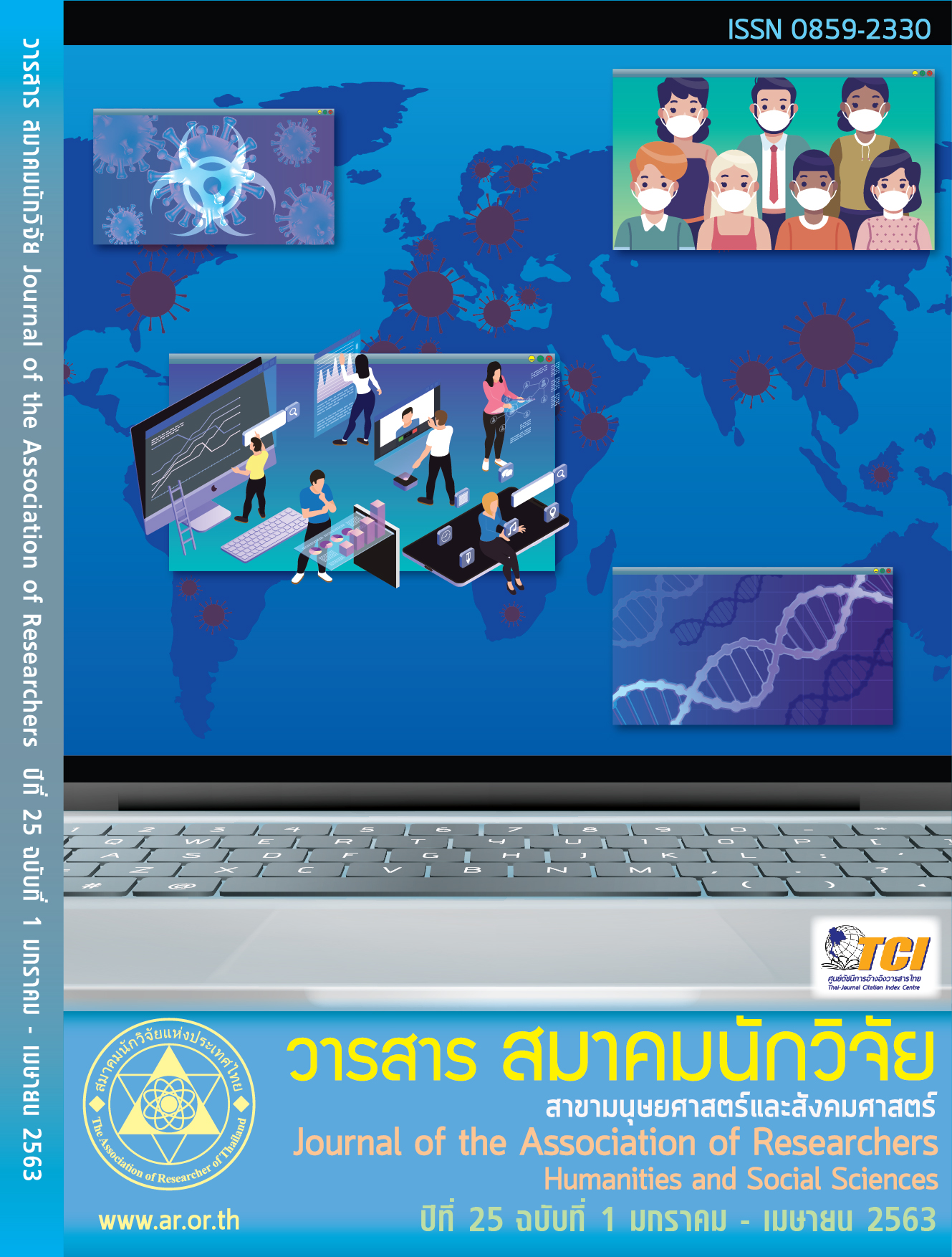Influence of electronic word of mouth and travel motivations on attitude towards traveling of Thai elderly tourists
Main Article Content
Abstract
The purpose of this study is to examine the influencing among e-WOM, travel motivations and travel attitudes of Thai elderly tourists. The sample population were senior tourists who were ages above 55 years. The online-questionnaires were designed in order for data collection with a snowball sampling technique. The total usable number of responses were 154. The statistics treatment of this study based upon the descriptive analysis such as percentage means, standard deviation and structural equation modeling (SEM) approach were employed to test the research hypotheses by applying the SPSS and AMOS. The Results indicated that the conceptual model perfectly aligns with the empirical data and both e-WOM. It was shown a significant positive effect on motivations at significance level 0.01 and motivations had a significant positive effect on travel attitude at significance level 0.01. Significantly, the findings indicated that e-WOM has a direct impact on travel motivations and an indirect impact on travel attitude. Therefore, tourism business operators can lunch a communication plan by creating a reviewing platform online through various media in order to enhance the motivations and the travel attitude among elderly tourists.
Article Details
บทความที่ปรากฏในวารสารนี้ เป็นความรับผิดชอบของผู้เขียน ซึ่งสมาคมนักวิจัยไม่จำเป็นต้องเห็นด้วยเสมอไป การนำเสนอผลงานวิจัยและบทความในวารสารนี้ไปเผยแพร่สามารถกระทำได้ โดยระบุแหล่งอ้างอิงจาก "วารสารสมาคมนักวิจัย"
References
เมษายน พ.ศ.2560, จาก http://www.itd.or.th/wp-content/uploads/2015/05/20140827-ar_older_aec-v2.pdf
Jiravadee Rattanapaitrulchai. (2557). Senior Tourists : Thai new challenge booming since AEC.
Access on 10 April 2018, Retrieved from http://www.itd.or.th/wp-c ontent/uploads/2015/05/20140827-ar_older_aec-v2.pdf (In Thai)
นรินทร์ สังข์รักษา, สุภาภรณ์ พรหมฤาษี และธีรังกูร วรบำรุงกุล. (2559). รูปแบบและพฤติกรรมการท่องเที่ยวที่
ไร้ความเร่งรีบของนักท่องเที่ยวสูงอายุ ในภูมิภาคตะวันตกของประเทศไทย. วารสารวิชาการ มหาวิทยาลัยหอการค้าไทย มนุษยศาสตร์และสังคมศาสตร์, 36(2), 1-18.
Narin Sungrugsa, Supaporn Plomelersee and Theerungkoon Warabamrungkul. (2559). Styles and
Behavior in Slow Tourism for Senior Tourists in the Thai Western Region. University of the
Thai chamber of Commerce Journal Humanities and Social Sciences. 36(2), 1-18. (In Thai)
ศวิตา นพเกตุ. (2559). แรงจูงใจและการรับรู้คุณภาพบริการที่ส่งผลต่อ ความพึงพอใจและการสื่อสารแบบปาก
ต่อปากของนักท่องเที่ยวชาวยุโรปที่ใช้บริการเดย์สปา ในเขตเมืองพัทยา จังหวัดชลบุรี.
(บริหารธุรกิจมหาบัณฑิต วิทยานิพนธ์), มหาวิทยาลัยบูรพา, ชลบุรี.
Sawita Noppaket. (2559). Motive and Service Quality influenced on Satisfactiona and Word of
Mouth communication of European consumers at Day spa in Pattaya, Chonburi. MBA
thesis. Burapha University. Chonburi. (In Thai)
สวัสดิ์ วรรณรัตน์. (2561). โมเดลสมการโครงสร้างของการจัดการคุณภาพทั่วทั้งองค์กร นวัตกรรมและผลการ
ดำเนินการโซ่อุปทาน. เศรษฐศาสตร์และบริหารธุรกิจปริทัศน์, 14(1), 105-127.
Sawat Wanarat.(2561). A Structural Equation Model of Total Quality Management, Innovation
and Supply Chain Performance. Business Administration and Economics Review. 14(1), 105-127.(In Thai)
การท่องเที่ยวแห่งประเทศไทย. (2560). ข่าวสารการท่องเที่ยวแห่งประเทศไทย [Press release].
สืบค้นจาก http://tatnewsthai.org/detail.php?newsID=327
Tourism Authority of Thailand. (2560). TATNEWSTHAI. Retrieved from
http://tatnewsthai.org/detail.php?newsID=327 (In Thai)
สำนักงานพัฒนาธุรกรรมทางอิเล็กทรอนิกส์(องค์การมหาชน). (2560). รายงานผลการสำรวจพฤติกรรมผู้ใช้
อินเทอร์เน็ตในประเทศไทย ปี 2560. สืบค้นจาก
https://www.etda.or.th/publishing-detail/thailand-internet-user-profile-2017.html
Electronic Transactions Development Agency (Public Organization). (2560). Thailand Internet
User Profile 2017. Retrieved from https://www.etda.or.th/publishing-detail/thailand-internet-user-profile-2017.html (In Thai)
สุจิตรา ไชยจันทร์. (2016). ทัศนคติที่มีต่อการท่องเที่ยวในประเทศไทยและแนวโน้มพฤติกรรมการท่องเที่ยว
ของกลุ่ม Baby boomer ในเขตกรุงเทพมหานครและปริมณฑล, Srinakharinwirot Research
and Development (Journal of Humanities and Social Sciences), 8(15), 160-181.
Sujitttra Chaijan . (2016).Attitudes and Behavioral Intention toword Tourism in Thailand among
baby boomer group in Bangkok and its vicinity. Srinakharinwirot Research and
Development (Journal of Humanities and Social Sciences), 8(15), 160-181 (In Thai)
อาคีรา ราชเวียง. (2017). การโฆษณาออนไลน์ด้านการท่องเที่ยวเพื่อกลุ่มผู้สูงอายุ. วารสารวิจัยและพัฒนาวไลย
อลงกรณ์ ในพระบรมราชูปถัมภ์ สาขามนุษยศาสตร์และสังคมศาสตร์, 12(1), 119-128
Akera Ratchanvieng.(2017). Online Tourism Advertising for the elderly group. VRU Research and
Development Journal Humanities and Social Science. 12(1), 119-128 (In Thai)
References
Arenas-Gaitan, J., Javier Rondan-Cataluña, F., & Esteban Ramírez-Correa, P. (2013). Social identity,
electronic word-of-mouth and referrals in social network services. Kybernetes, 42(8), 1149-1165. doi:10.1108/k-04-2013-0081
Bashar, A. A. M., & Abdelnaser, O. (2011). An Investigation into Motivational factors that
influencing foreign tourist’ to visit Jordan. Pudh and Pull factors. Journal of Environmental Management & Tourism, 2(1), 16-23.
Chang, L.-Y., Lee, Y.-J., & Huang, C.-L. (2010). The influence of e-word-of-mouth on the consumer's
purchase decision: A case of body care products. Journal of Global Business Management, 6(2), 1.
Coulter, K. S., & Roggeveen, A. (2012). “Like it or not”. Management Research
Review, 35(9), 878-899. doi:10.1108/01409171211256587
Harrison-Walker, L. J. (2001). The measurement of word-of-mouth communication and an
investigation of service quality and customer commitment as potential antecedents. Journal of service research, 4(1), 60-75.
Horner, S., & Swarbrooke, J. (2016). Consumer behaviour in Tourism (Third ed.). Unite state of America: Routledge.
Hsu, C. H., Cai, L. A., & Li, M. (2010). Expectation, motivation, and attitude:
A tourist behavioral model. Journal of travel research, 49(3), 282-296.
Jalilvand, M. R., Ebrahimi, A., & Samiei, N. (2013). Electronic Word of Mouth Effects on Tourists’
Attitudes Toward Islamic Destinations and Travel Intention: An Empirical Study in Iran.
Procedia - Social and Behavioral Sciences, 81, 484-489. doi:https://doi.org/10.1016/j.sbspro.2013.06.465
Kotler, P. (2000). Marketing Management:The Millennium Edition (Intenational ed.).
United States of America: Prentice-Hall International.
Pallant, J. (2007). SPSS survival manual, 3rd. Edition. McGrath Hill.
Tang, C. (2010). Understanding the electronic word-of-mouth communication process:
Communication effectiveness and analytic tools. (DOCTOR OF PHILOSOPHY), The University of Arizona,
Torres Chavarria, L. C., & Phakdee-auksorn, P. (2017). Understanding international tourists'
attitudes towards street food in Phuket, Thailand. Tourism Management Perspectives,
21, 66-73. doi:https://doi.org/10.1016/j.tmp.2016.11.005
Wang, J., & Wang, X. (2012). Sample Size for Structural Equation Modeling.
In W. A. Shewhart & S. S. Wilks (Eds.), Structural Equation Modeling.
Westland, J. C. (2010). Lower bounds on sample size in structural equation modeling.
Electronic Commerce Research and Applications, 9(6), 476-487.
Wong, M., Cheung, R., & Wan, C. (2013). A Study on Traveler Expectation,
Motivation and Attitude. Contemporary Management Research, 9(2), 169-185.
Yang, C.-C., Marlow, P. B., & Lu, C.-S. (2009). Assessing resources, logistics service capabilities,
innovation capabilities and the performance of container shipping services in Taiwan.
International Journal of Production Economics, 122(1), 4-20. doi:https://doi.org/10.1016/j.ijpe.2009.03.016
Yarimoglu, E. K. (2014). Online Customer Experience (A. Ghorbani Ed. Vol.
Marketing in the cyber era:strategies and emerging trends). Unite state of America
: Business Science Reference(an imprint of IGI Global)


